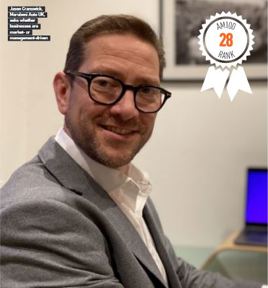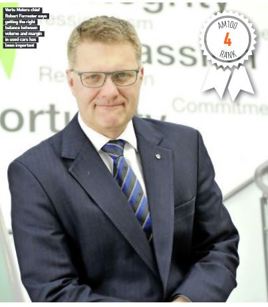Just before the close of 2023, AM deputy editor Aimée Turner caught up with three AM100 dealer group leaders – Jason Cranswick (JC), chief operating officer of Marubeni Auto UK, which owns Norton Way Motors, RRG Group and HPL Motors; Chris Clark (CC), managing director of John Clark Motor Group; and Robert Forrester (RF), chief executive of Vertu Motors – to discover what are the opportunities of 2024 and what were the challenges of 2023.
How was your group’s trading performance in 2023?
JC: FY23 has brought back into question whether businesses are “management-driven” or “market driven”. Looking back to the past two years, for sure, the market has helped the automotive retail sector have a good run. In this financial year we have focused on making really good management decisions and finding countermeasures to the pressures of inflation, changes in consumer confidence and movements in vehicle supply. We are confident the actions we are taking will mean that our business will once again produce good shareholder value and material profitability.
Just before the close of 2023, AM deputy editor Aimée Turner caught up with three AM100 dealer group leaders – Jason Cranswick (JC), chief operating officer of Marubeni Auto UK, which owns Norton Way Motors, RRG Group and HPL Motors; Chris Clark (CC), managing director of John Clark Motor Group; and Robert Forrester (RF), chief executive of Vertu Motors – to discover what are the opportunities of 2024 and what were the challenges of 2023.
How was your group’s trading performance in 2023?
JC: FY23 has brought back into question whether businesses are “management-driven” or “market driven”. Looking back to the past two years, for sure, the market has helped the automotive retail sector have a good run. In this financial year we have focused on making really good management decisions and finding countermeasures to the pressures of inflation, changes in consumer confidence and movements in vehicle supply. We are confident the actions we are taking will mean that our business will once again produce good shareholder value and material profitability.
CC: We’ve had a really good year so far. Q1 and Q2 were broadly in line with last year despite there being ongoing new car supply issues and used stock constraints. We’ve been able to drive the quality of business we are writing and safeguard our sales margins and F&I performance.That said, Q3 has been more challenging and I don’t think that’s going to change as we progress through the final quarter.
RF: We’ve just done interims for the six months ending August which were well received by shareholders – our second strongest first half profit, at £31.5 million, on the back of better supply of new cars, strong margins in pretty well every sector and a consistently strong aftersales performance, particularly from much stronger margins in our accident and repair centres.At the start of the year, my biggest objective was to significantly increase the number of technicians we have in the service department. We increased them from March to the end of August by 54 – having started with 843 – so that’s quite a significant increase.We haven’t probably yet seen the full benefit as that will come through the second half.
What were the major factors at play? How did they impact your businesss pecifically?
 JC: The big-ticket items we have all been focused on are balancing inflationary rises with softening margins. As a business we had the opportunity to create harmonies and efficiency between our business units – Norton Way, RRG and HPL. Our aim is to create vertical integration and broad geographical coverage, so we can optimise the scale benefits this now brings to us.We came into CY23 having completed the majority acquisition of the leading used car supermarket business HPL Motors and this has brought into our senior leadership team some unique and specific skills that major groups need to capitalise on the addressable market for used cars and vehicle lifetime value.Alongside this, we have worked hard on aligning our franchised dealer core business, maintaining independence, but leveraging group scale and expertise.
JC: The big-ticket items we have all been focused on are balancing inflationary rises with softening margins. As a business we had the opportunity to create harmonies and efficiency between our business units – Norton Way, RRG and HPL. Our aim is to create vertical integration and broad geographical coverage, so we can optimise the scale benefits this now brings to us.We came into CY23 having completed the majority acquisition of the leading used car supermarket business HPL Motors and this has brought into our senior leadership team some unique and specific skills that major groups need to capitalise on the addressable market for used cars and vehicle lifetime value.Alongside this, we have worked hard on aligning our franchised dealer core business, maintaining independence, but leveraging group scale and expertise.
CC: New car supply constraints have continued through the first half of the year. So, we’ve had to work hard to manage customer expectations while also retaining our order bank.We can see this position changing as we move into Q4 with a lot of brands preparing for a big final quarter and stock availability looking to be in a good position as we close out 2023. Challenges around used car supply have been well documented this year and, while we are slightly back on budgeted volumes, I’m still really pleased with the way we’ve navigated this issue, investing significantf ocus on retaining as many part exchanges as we can. Through this we achieved a 70% retained p/ex ratio and this really made the difference to our used performance.Aftersales resource has been a challenge for us but, again, we managed to mitigate the impact this had through the strength of our own apprentice programme which continues to go from strength to strength. We’ve also worked hard on our colleague retention programme and have driven turnover down year on-year by nearly 6%.
RF: Controlling cost was pivotal. We’re fortunate that we’ve got in-house software developers who can help us to take cost out and make us more productive by deploying technology. Making sure we get the right balance between volume and margin in used cars was really important. We saw a period of reasonable stability of used car pricing and reasonably sustained shortages over the past couple of years, so we took the view that we would increase stock in H1. When we came into September, we saw a slightly different market position, which will lead to an adjustment of execution. Whereas actually in the past 12 months, used electric vehicles have been the area where we’ve seen sustained depreciation – 45% cheaper than they were 12 months ago – we’re now seeing weakness in high-end premium, anything more than £80,000. Clearly, our strategy will be to make sure we turn the stock and control stock levels. We’re not in an interest free environment now so it’s actually quite important that we manage the interest as well. So, we’ll probably be tighter on stock.
This article was first published in the December 2023 AM100 report, available to read freely here in digital format.
Can you describe a major initiative and how its implementation fared during the year?
 JC: During this year we have focused on enhancing our retail facilities while at the same time strengthening our omni-channel capabilities. We firmly believe that consumers have a real connection with spending time in dealership environments that showcase the brand. We also recognise that we need to be able to offer class-leading online services for new car, used car, service and parts. All dealers have double-downed on this post-COVID, energised by disrupters raising the bar. To successfully make the connection between physical and digital, you need to have a digital and data architecture that is well organised, seamlessly integrated and delivers easy customer journeys. This year has enabled us to redefine the “wiring diagram” that underpins our system architecture and we will be using this to guide our decision-making in the future for the third party partners we engage with and the technology stack that we subscribe to. We are making decisions that will impact our ability to move at pace, and for a retail landscape that will continue to evolve over the next three-to-five years.
JC: During this year we have focused on enhancing our retail facilities while at the same time strengthening our omni-channel capabilities. We firmly believe that consumers have a real connection with spending time in dealership environments that showcase the brand. We also recognise that we need to be able to offer class-leading online services for new car, used car, service and parts. All dealers have double-downed on this post-COVID, energised by disrupters raising the bar. To successfully make the connection between physical and digital, you need to have a digital and data architecture that is well organised, seamlessly integrated and delivers easy customer journeys. This year has enabled us to redefine the “wiring diagram” that underpins our system architecture and we will be using this to guide our decision-making in the future for the third party partners we engage with and the technology stack that we subscribe to. We are making decisions that will impact our ability to move at pace, and for a retail landscape that will continue to evolve over the next three-to-five years.
CC: We’ve invested heavily in the installation of photovoltaic systems this year and now have a number of schemes up and running alongside on-site battery storage solutions.There were some challenges around supply to begin with and there have also been challenges around contractor capability, but we are now seeing a huge impact on energy costs.This success has seen a plan for a full roll-out over the next two years across the rest of our facilities.
RF: We had probably six different strategies to increase the number of technicians including flexible working patterns; marketing the vacancies and increasing the number of apprentices – though that’s quite a slow burn – also, looking at schemes to bring in non-franchised technicians to get them trained quickly with manufacturers and we restructured pay. Put all that together, we were very successful in recruiting.
Cost control continues to be challenging, but how has your business protected its profitability?
JC: We continue to look at how we can defend our margins while also minimising any leakage within our revenues. We continuously look for opportunities to strengthen our customer processes for “opportunity” conversion and retention.In 2023 we have continued to focus on developing the skills of our teams with business-wide programmes of sales and service core processes. We have also looked to enrich the sales mix of new, used and workshops sales to make sure we leave no stone unturned. In fairness – we are doing like all other dealers, we are aiming to be brilliant at the basics.
CC: Over the past few years we’ve concentrated on internalising as much of our expenditure as possible. We’ve brought much of our SMART and cosmetic repair in-house, increased investment in aftersales capacity, brought on-line our own internal transport department, installed our own photographic and digital display teams, to name but a few measures. Clearly the expense remains but it’s now internal spend against relatively low levels of investment.
 RF: The biggest element of cost control that’s quite hard to manage at the moment is interest costs. Our core debts, we’ve hedged out, so that’s not too much of an issue. We can probably reduce used car-related interest by reducing these costs, but the big increase was really in manufacturer stocking charges, where manufacturers increased the rates we were charged on the new car pipeline and reduced the level of interest-free stocking periods. That is quite challenging, especially given there can be bubbles of stock. Actually, it’s one of the benefits of moving to the agency model in that you actually don’t have any of that. So, we’ve got to try to work with the manufacturers to reduce that exposure through the networks in terms of manufacturer stocking charges which have become quite significant although that will be the same for everybody.
RF: The biggest element of cost control that’s quite hard to manage at the moment is interest costs. Our core debts, we’ve hedged out, so that’s not too much of an issue. We can probably reduce used car-related interest by reducing these costs, but the big increase was really in manufacturer stocking charges, where manufacturers increased the rates we were charged on the new car pipeline and reduced the level of interest-free stocking periods. That is quite challenging, especially given there can be bubbles of stock. Actually, it’s one of the benefits of moving to the agency model in that you actually don’t have any of that. So, we’ve got to try to work with the manufacturers to reduce that exposure through the networks in terms of manufacturer stocking charges which have become quite significant although that will be the same for everybody.
What would you have done differently this year – supposing you had the benefit of hindsight?
JC: I’m not a big fan of hindsight, I would much rather focus on how we gain foresight, so I will be looking ahead at the opportunities that the market shows and making sure our management decisions are, more often than not, great decisions.
CC: We put stock managers in place in a couple of our divisions. This provided an increased level of resource and attention on stock presentation, quality, pricing, sourcing and margin control. Considering the challenges the industry has faced around used supply, given this resource opportunity again, I’d have put this in place across every division.
RF: Absolutely nothing. Because all you can do is make the right judgement at the right time. Certainly, we change our views on things.
 Where do you see as the key opportunities for 2024?
Where do you see as the key opportunities for 2024?
JC: Working closely with our brand partners to navigate the market, while leveraging the scale and experience we have across our broad business base. The growth in the super-groups, fuelled by the big US-based operators looking to move further into the UK market, means a business like ours needs to offer amazing customer and colleague experiences, while constantly seeking ways of showing agility and regional expertise.
CC: I think 2024 will see a significant increase in new vehicle supply andthis will bring great opportunities. However, clearly this needs to be balanced against the wider economic picture. Once the general election is confirmed I think we will need to watch consumer confidence levels to ensure we retain the pull effect for as long as possible. If this is navigated and managed well by the OEMs and ourselves then this should present opportunity for a good year. But that is a big “if”. Our other area of investment will be in software development to automate some of our key processes to increase efficiencies. We have just kicked this project off, but I’m really excited about the potential benefits.
RF: We’re moving from undersupply to oversupply and we’ve got a new car market back into resurgence as well as a reasonably strong used car market. So, the biggest challenge is making sure we’ve got the right quantity and quality of sales team. Can they do objection handling and close deals? We have a massive focus on that at the moment. Would I have started that sooner? You can only get an organisation to focus on a certain number of things and, if I'd said "right I'll sort out my sales skills sooner" I probably wouldn't have recruited all the technicians we did.
Login to continue reading
Or register with AM-online to keep up to date with the latest UK automotive retail industry news and insight.
















Login to comment
Comments
No comments have been made yet.